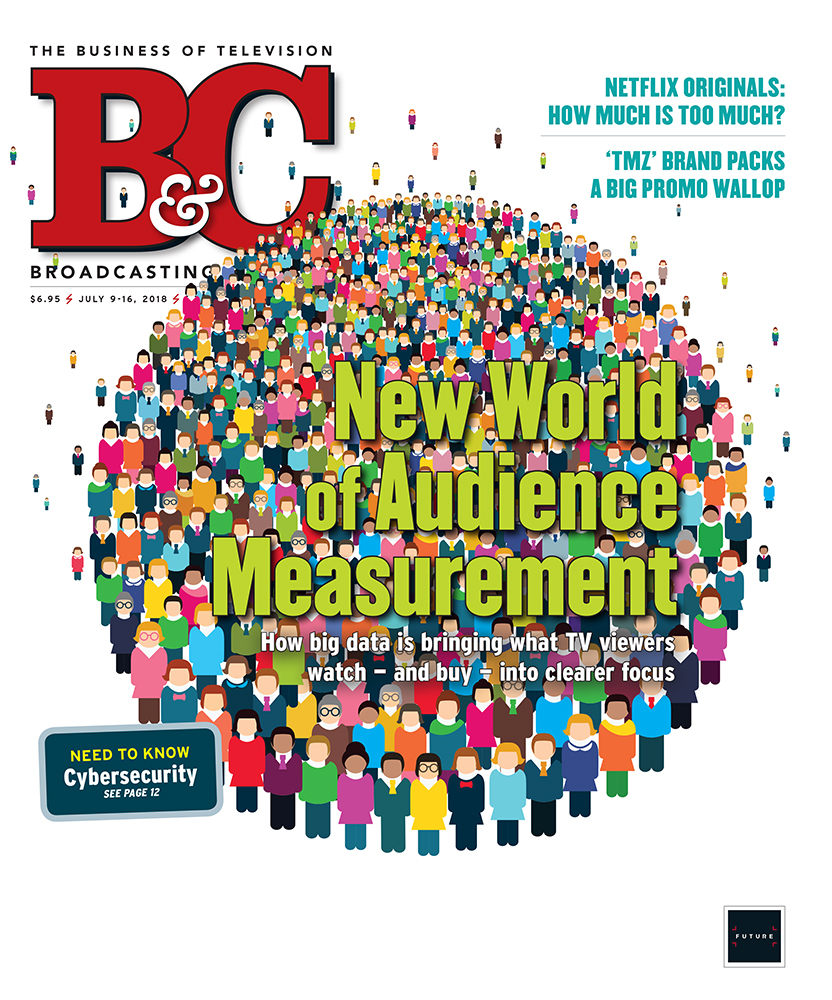Data Drives TV Measurement’s Next Generation

Why This Matters: In its battle with digital competitors, TV networks are turning to analytics startups who turn big data into a clearer picture of who’s watching and what viewers are buying.
A wave of data has launched a flotilla of new research and analytics companies that aim to provide new information and insights about television viewing.
Challenged by digital competitors and concerned that shrinking ratings, stagnant ad revenue and cord-cutting will reduce pay TV subscriptions, programming networks appear eager to learn about changing consumer behavior.
Networks are also thirsting for data that proves what most marketers already believe: TV advertising is effective both in building brands and generating sales.
While some of the digital giants have been providing ad clients with their own research on how many people they reach — marketers are increasingly skeptical about this data — TV networks are accustomed to getting numbers from third parties in order to avoid the charge that they’re grading their own homework.

One top network researcher, CBS executive VP, chief research and analytics officer Radha Subramanyam, said she has a spreadsheet on her desk that lists 27 companies the network is in discussions with about providing attribution metrics.
“It’s a great, wonderful, fruitful time to be a researcher because we really literally have never had so much data,” Subramanyam said.
Broadcasting & Cable Newsletter
The smarter way to stay on top of broadcasting and cable industry. Sign up below
When Disney/ABC Television Group announced its Luminate suite of advanced advertising products, it said that data companies including Data Plus Math and Samba TV were involved. NBCUniversal is working with analytics firms, including iSpot.TV and Canvs, on various initiatives.
Some of these new firms see themselves as partners with Nielsen. Others see themselves as competitors.
Pivotal Research Group analyst Brian Wieser pegged the U.S. TV research market at $3 billion, almost all of that Nielsen. The new firms “believe that TV measurement as a sector is waiting to be disrupted,” Weiser said. “With all the complaints that industry participate have, it’s understandable that there would be venture capital available to fund entrepreneurs with ideas intended to disrupt the market.”
But at this point, age and gender are the dominant metrics for buying and selling advertising and “Nielsen persists because it is the least bad alternative,” in measuring that, Wieser said. Should a new targeting metric emerge, “Nielsen could still be an important supplier of data but it’s the age/gender which it utterly dominates.”
What does Nielsen say?

“We applaud any work being done to progress measurement and help drive advertising efficiency for the industry,” Kelly Abcarian, senior VP of product leadership at Nielsen, told B&C. “But there is a reason Nielsen data remains the linchpin of TV media advertising, whether it is traditional demographic or advanced audience segmentation targets: We can measure what marketers are buying advertisements for — to reach the actual consumers they are targeting, rather than households.”
There is a pressing need for these new measurement companies, which are bringing innovation and speed to the market, former Turner chief research officer Howard Shimmel said.
Longer-term, though, he said it was hard to see them surviving as small, spunky research companies. “Whether they get acquired or partner with some other small companies, you do need some scale to be real,” Shimmel said.
Some of this torrent of new data is coming from set-top boxes from multichannel video programming distributors. A newer source is from smart TVs.
Inscape, a division of Vizio, generates and licenses viewing data from 8.8 million smart TV sets whose owners have opted in to ad tech companies, media buyers and networks including NBCUniversal. NBCU’s Audience Studio uses the data to target ad campaigns.
Stepping on the Gas
“We are high-grade gasoline and that high-grade gasoline is used to power a bunch of different platforms,” Inscape senior vice president Jodie McAfee said. Those platforms generally provide measurement, analytics and targeting for TV.
“Our intent is to be as ubiquitous as possible. We don’t choose winners and losers. There are going to be winners and losers,” McAfee said. “This whole landscape is going to be incredibly chaotic and fluid over the next three to five years.”
Inscape has doubled the number of partners it works with in the first quarter to a total of about 20, according to McAfee. “We’ve got literally dozens and dozens and dozens of companies in the queue right now,” he said.
Here is a look at some of these upstart measurement firms.
No Shortcuts
One of the companies relying on Inscape data is iSpot.TV. Its CEO, Sean Muller, said it’s a great time to be a data and analytics company.
“There are a lot of companies who aren’t data and analytics companies that are creating the perception that they’re data and analytics companies, when it’s not their core business,” Muller said.
Six years ago, iSpot.TV started building a platform that catalogues ads and tracks when they air on TV. “Today, we have a proprietary data set that allows us now to connect TV ad impressions to business outcomes,” Muller said.
NBC is using iSpot.TV’s data to validate that ad campaigns produce results.
“There are no shortcuts,” Muller said. “We had to invest five, six years and $50 million into building this system. You can’t just go and get this data off the shelf. This data doesn’t exist off the shelf.”
Attribution Revolution
Analytics company Data Plus Math has built a high profile in the crowded field of measuring the impact of TV ads, also known as attribution.

“The space is heating up and getting momentum,” Data Plus Math CEO John Hoctor said. “Television’s really embracing these new and different data sets, new ways of looking at the inventory and it’s a period of really rapid innovation.”
Doing attribution isn’t easy, Hoctor said. In order to figure out how one network is driving results for an advertiser, compared another network, “you need to spend a lot of time, and you have to look at a lot of data and you’ve got to develop models.”
With Google and Facebook providing ad clients with data, even if that data is questionable, TV networks are ponying up more money to provide similar information. “Media sellers have been working with us because they know that’s table stakes,” Hoctor said.
A+E Networks is offering some advertisers guarantees based on Data Plus Math calculations of how much campaigns increase website visits or foot traffic to stores.
“Television has begun to lose the ROI narrative in recent years as the big digital players have convinced marketers that they deserve an undue amount of credit when it comes to consumer behavior,” A+E executive vice president for ad sales Peter Olsen said. “Working with companies like Data Plus Math is helping TV level the playing field and getting the credit we believe it deserves.”
Cable Connection
605, a data and analytics company formed last year, jumped into the attribution pool in May when it launched its Impact Index, designed to measure both the branding and sales impact of TV advertising.

“In the last 18 months, there’s been a real shift among the programmers who are now starting to embrace audience-based selling,” Ben Tatta, 605’s co-founder and president, said. At the same time, the availability of data enables many ways to measure the impact of campaigns.
“Now, all of a sudden, there are a number of different solutions and it can be confusing,” Tatta said.
The set-top box data 605 works with gives it an advantage in measuring how campaigns work for clients like Walmart and Uber, he said. “Because it’s behind a paywall, it comes with authenticated credentials,” Tatta said. “It’s not inferred based on a cookie. The fact that it’s fully credentialed and the impressions are authenticated and the data is authenticated, I really think it does put us in a unique spot to battle things like fraud and a lot of the issues on the web in terms of overstatement of impressions.”
Making Connections
For Samba TV, “data is the most valuable thing that we bring to the media community right now,” co-founder and CEO Ashwin Navin said. In addition to data from 14 million households in the U.S., Samba has access to data from 5 million TV households outside the U.S.
Samba’s data help identify audiences for programmers deciding which shows to bring back and which ones to cancel. It is also used to inform their marketing aimed at reconnecting with viewers who had been watching a program as well as effort to convert new viewers.
“We can connect the dots between the promotion and the consumption in a closed-loop attribution model. For entertainment marketing it was an unprecedented thing,” Navin said.
Computers Are Watching
Picture a data center in Red Bank, N.J., filled with computers watching TV. That’s how Alphonso indexes TV, from live linear networks to over-the-top content. “If there was an exposure to a program or an ad, we can provide various types of analysis in relation to that exposure,” senior VP of research T.S. Kelly said.
“Right now we’re working with a quick service restaurant,” he said. “We can tie the exposure to their campaign to direct visitation to their restaurant. So we give them visitation or location attribution, as we call it.”
Alphonso is also able to break down which networks, dayparts and programs were most effective at delivering visitors to the store, he said.
The new data coming from these new attribution companies appears to be proving that TV is an effective ad medium.
Nielsen also provides metrics for TV ad effectiveness that it thinks paints a true picture of ROI.
“We believe buyers understand the value of representative persons-based measurement and will continue to opt for Nielsen as their measurement provider both for buying on age/gender demographics as well as audience segments based on persons measurement,” Nielsen’s Abcarian said.
Said CBS’s Subramanyam: “Everyone knows TV works. Everyone knows premium video works. And now we just have more and more ways of proving beyond a shadow of a doubt that it works better than any medium.”
Paying Attention
With ratings down, TV networks are looking for different ways of measuring engagement with viewers. Some, like Fox, have embraced attention as a key attribute they bring to advertisers.
“We are talking to different vendors who have different definitions of how you measure attention,” Fox executive VP of sales research insight and strategy Audrey Steele said. “I think that movement has definitely caught fire in the industry, to focus on attention and focus on what you get when you try to improve the viewing experience for your audience.”
TV watching has changed, noted Dan Schiffman, chief research officer at TVision. The explosion of digital devices and platforms on which content can be consumed has not only fragmented audiences, but viewer attention as well.
Historically, TV measured impressions, which have become eyeballs with the opportunity to see a program or an ad.
“Then there’s the second layer, which is a little bit deeper and that’s actual attention, actual eyeballs on screen,” Schiffman said. TVision uses a panel that’s active 24 hours a day in the top 10 markets. Technologies including facial recognition and skeleton tracking help TVision figure out who is in the room and when they’re paying attention on a second-by-second basis. The data is used to create an index applied to total viewing statistics.
“We work with the networks to help evangelize attention as it can benefit them,” Schiffman said. “We’ve also provide the data to them so they can provide it back to advertisers to demonstrate how that advertiser’s performing in term of getting attention in the context of their environment.”
Video Goes Social
TV networks are also putting video on social-media platforms.

“We’re tracking every video on Facebook, YouTube, Instagram, Twitter, about 4 billion videos uploads by 12 million publishers,” Tubular chief marketing officer Allison Stern said. Those publishers could be traditional broadcast and cable networks or digital first publishers, influencers or brands.
It also analyzes branded content it finds online.
“Tubular aims to be the future of measurement in terms of the content we’re measuring and also in terms of what we define as measurement, which is not just stats and data but true insight into who is your audience and what is trending and what can you be doing to create content that truly resonates with the younger audiences that are shifting their attention away from traditional TV,” Stern said.
CBS’s Subramanyam sees more insights coming down the pike, thanks partly to these new data firms.
“I’ve done this close to 20 years at this point,” she said. “And I’m shocked by how much new I’m learning every single day.”
Jon has been business editor of Broadcasting+Cable since 2010. He focuses on revenue-generating activities, including advertising and distribution, as well as executive intrigue and merger and acquisition activity. Just about any story is fair game, if a dollar sign can make its way into the article. Before B+C, Jon covered the industry for TVWeek, Cable World, Electronic Media, Advertising Age and The New York Post. A native New Yorker, Jon is hiding in plain sight in the suburbs of Chicago.

